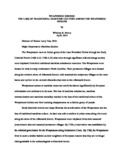WEAPEMEOC SHORES : THE LOSS OF TRADITIONAL MARITIME CULTURE AMONG THE WEAPEMEOC INDIANS
Author
Petrey, Whitney R.
Abstract
The Weapemeoc were an Indian group of the Late Woodland Period through the Early Colonial Period (1400 A.D.-1780 A.D.) that went through significant cultural change as they were displaced from their traditional maritime subsistence resources. The Weapemeoc were located in what is today northeastern North Carolina. Their permanent villages were located along the northern shore of Albemarle Sound, with seasonal and temporary villages on the outer banks and upriver on the several tributaries that drain to the Albemarle Sound. Weapemeoc access to maritime resources would be altered significantly by European colonization and settlement in the area. The loss of maritime subsistence, maritime communication and maritime mentality resulted in the loss of the traditional culture of the Weapemeoc Indians and their seeming disappearance as a distinct group of people. Early historical records and maps illustrate the acculturation of the Weapemeoc and the loss of traditional maritime culture. As land was sold to settlers in prime areas along rivers and along the shore of the Albemarle Sound, Weapemeoc were displaced from their seasonal procurement sites and seasonal permanent villages. By 1704, a reservation was established by the colonial government for the Weapemeoc along Indiantown Creek. By 1780, the Weapemeoc lived in such a similar fashion as their neighbors of European descent that they are no longer distinguishable in the archaeological or historical record.
Date
2014
Citation:
APA:
Petrey, Whitney R..
(January 2014).
WEAPEMEOC SHORES : THE LOSS OF TRADITIONAL MARITIME CULTURE AMONG THE WEAPEMEOC INDIANS
(Master's Thesis, East Carolina University). Retrieved from the Scholarship.
(http://hdl.handle.net/10342/4534.)
MLA:
Petrey, Whitney R..
WEAPEMEOC SHORES : THE LOSS OF TRADITIONAL MARITIME CULTURE AMONG THE WEAPEMEOC INDIANS.
Master's Thesis. East Carolina University,
January 2014. The Scholarship.
http://hdl.handle.net/10342/4534.
June 29, 2024.
Chicago:
Petrey, Whitney R.,
“WEAPEMEOC SHORES : THE LOSS OF TRADITIONAL MARITIME CULTURE AMONG THE WEAPEMEOC INDIANS”
(Master's Thesis., East Carolina University,
January 2014).
AMA:
Petrey, Whitney R..
WEAPEMEOC SHORES : THE LOSS OF TRADITIONAL MARITIME CULTURE AMONG THE WEAPEMEOC INDIANS
[Master's Thesis]. Greenville, NC: East Carolina University;
January 2014.
Collections
Publisher
East Carolina University

